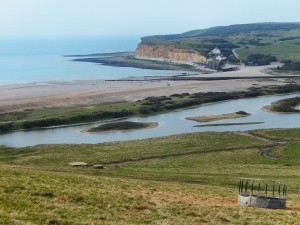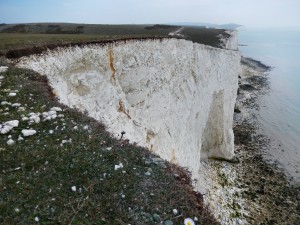
Down in Sussex for a few days, we walked the Seven Sisters from Cuckmere Haven to the Birling Gap.
We had a taste of the scale of human interference with the world’s climate in the shape of a thick haze of pollution trapped by an anticyclone: on the Weald approaching Lewes, we could see the thick haze below the level of the South Downs, and taste the acridity on our tongues. On the coast itself, it was less noticeable in the sea breeze, but the visibility was much reduced with the Newhaven-Dieppe ferry quickly fading into the murk. The BBC warned of high local pollution (worst near Hastings) and an expert advised against strenuous exercise.
The photo of Cuckmere Haven had to be enhanced as it actually looked all washed out in the haze. The geography is interesting: the Cuckmere River emerges (as a dark horizontal line) through what looks from this viewpoint like a continuous shingle bar across the mouth of the valley. The ‘lagoon’ on the landward side of the shingle is part of a former meander of the river, now cut off as if it were an oxbow lake; the current watercourse is canalized with artificial embankments. In the background are vertical sea-cliffs of chalk, with softer (brown) sands above, eroding at a shallower angle. At the base of the cliffs is a white line of fallen chalk rubble, and a dark horizontal surface, a wave-cut platform of chalk (with dark seaweed). In the foreground is the slope of chalk grassland and (left centre) two wartime concrete pillboxes defending the haven.

Gingerly approaching the cliff edge at a crawl, I took this photo, showing a large cave in the chalk: the waves fracture and undercut the cliff at high tide, causing progressive and often sudden cliff falls. The coastline recedes by about 70cm per year, but this bland average conceals a very different reality: the cliff edge barely changes from one year to another, until in some specially violent winter storm, perhaps three to five metres of chalk grassland and hundreds of thousands of tons of chalk suddenly collapse all at once into a gigantic white heap on the beach. The cave in the photo has created an overhang of more than 10 metres; it will certainly collapse one day in the next few years.
The walk was constantly accompanied by the song-flights of Skylarks, and their darting duels low over the grass. A few Ravens flew about the cliffs, and many Jackdaws; a pair of Carrion Crows mobbed a Raven; a few Magpies brought the number of members of the Crow tribe up to four. Near Birling, Chiffchaffs crept about an orchard, and Blackcaps dived into gorse bushes. Hundreds of Brent Geese flew Eastwards in V-shaped skeins or long lines half a wingspan above the waves. Four or five Little Egrets darted about the Cuckmere Haven lagoon, spearing small fish: a century ago they were hunted to local extinction for their plumes, used for elegant ladies’ hats. The RSPB was founded partly as the “Fin, Fur and Feather League”, a women’s campaign against the cruel and pointless use of animals in fashion that became a major force in bird conservation. In the last thirty years or so they have quietly returned to the south coast and are increasing in numbers.
